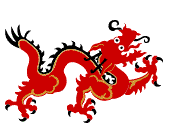On October 12, 2007 at Fort Benning, Georgia, representatives of the 35th ISPD (Scout Dog Handlers) will be presenting a special plaque to be displayed permanently in the Scout Dog Handler Museum at Fort Benning. We are hoping many of you from all handler units can join us for this fulfilling event. The 35th often supported the 2nd of
the 28th near Dau Tieng by scouting for their patrols. The 2nd of
the 28th is a proud, historic part of the First Infantry Division.
They earned the title "Black Lions of Cantigny" in 1918 when
they captured that French village in World War I. The 28th was ambushed on October 17, 1967; 63 men were wounded and 56 were killed, including the commanding officer, Terry Allen, Jr., whose father formerly commanded the First Infantry Division. This was considered the worst ambush suffered by Americans during the Vietnam War. During the late 60s and early
70s, the 35th kept a French officer's black baton that was carved in the
form of a Napoleonic eagle. Legend had it that it had once
belonged to the French Foreign Legion when they headquartered at the
Michelin, but no one knows the baton's exact origin. The
"stick" as we called it, was always passed on to the
scout/handler who was "shortest" or closest to going home.
The stick was viewed by us as a symbol of survival and hope, and became
an emblem of the 35th. As a few of the 35th veterans have gathered
together over the years since the war, they passed the stick among
themselves and today, it is mounted on a plaque. The following
quote from Oliver Wendel Holms is inscribed on the plaque: "We
have shared the incommunicable experience of war. We felt - we
still feel - the passion of life to its top . . . in our youths, our
hearts were touched with fire."
On October 12, 2007, veterans
from the 35th ISPD will turn over our baton and plaque for permanent
placement in the Fort Benning Scout Dog Museum, both in memory of the
members of our unit who have passed on, and also in respect for the 2nd
of the 28th whom we were committed to protect. Mostly, we are
passing on a symbol of hope, believing that it will be of comfort and
inspiration to the Handler Scouts of the future who will also serve as
guardians, particularly of our brothers and sisters now serving in
Iraq, Afghanistan and Eastern Europe.
For Comments or Additional Information
|



